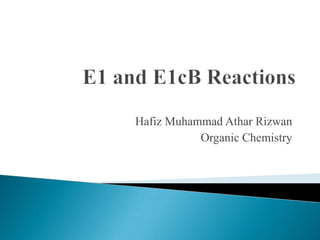
E1 reaction
- 1. Hafiz Muhammad Athar Rizwan Organic Chemistry
- 2. In an elimination reaction some fragments of a molecule are removed. Elimination reaction are classified into two general headings α-eliminations β-eliminations i
- 3. α-eliminations in which two groups are eliminated from the same atom. In this case unstable species are formed which undergo further reactions.
- 4. β-eliminations in which groups on adjacent atoms are eliminated with the formation of multiple bonds. H Base C C C C X
- 5. β-eliminations proceeds through two mechanisms which are E2 bimolecular elimination reactions E1 unimolecular elimination reaction The E2 and E1 mechanisms differ in the timing of bond cleavage and bond formation, analogous to the SN2 and SN1 mechanisms.
- 6. E1 indicates a elimination, unimolecular reaction. The E1 reaction proceeds via a two-step mechanism: the bond to the leaving group breaks first before the π bond is formed. The slow step is unimolecular, involving only the alkyl halide.
- 7. The dehydrohalogenation of (CH3)3CI with H2O to form (CH3)2C=CH2 can be used to illustrate the E1 mechanism.
- 8. Energy diagram for E1 reaction
- 9. 1. Dehydrohalogenation (-HX) and 2. Dehydration (-H2O)
- 11. CH3 CH3 slow H rapid CH3 CH3 C Br CH3 C + + B H + Br- - Br- C C CH3 H C H CH3 H H B:-
- 12. R H R R strong acid R C C R C C + H2O OH R R R
- 13. 1) CH3 CH3 + CH3 C CH3 + H CH3 C CH3 OH + OH2 2) CH3 CH3 slow CH3 C CH3 CH3 C CH3 + H2O + + OH2 3) CH3 CH3 + CH3 C CH3 C CH2 + H + CH3
- 15. 1) Substrate effect 2) Base effect 3) Isotope effect 4) Orientation of elimination
- 16. The order of the reactivity of the alkyl groupsis Tertiary> Secondary>Primary This is because the rate determining step is the formation of carbocation and the stability of these ions increases.
- 17. Tertiary (3o) > secondary (2o) > primary (1o) It is hard (but not impossible) to get primary compounds to go by E1. The reason for this is that primary carbocations are not stable!
- 21. Bulky Bases Favor Elimination
- 22. E1 reactions do not show an isotope effect: kH/kD = 1 This tells us that the C-D or C-H bonds are not broken in the rate determining step (step 1). They are broken in the fast step (step 2) in the mechanism).
- 23. E1 reactions faithfully follow Zaitsev’s rule! This means that the major product should be the product that is the most highly substituted.
- 24. In reactions of removal of hydrogen halides from alkyl halides or the removal of water from alcohols, the hydrogen which is lost will come from the more highly-branched b- carbon.
- 25. 1. Kinetics 2. Stereochemistry 3. Rerangement
- 26. E1 reactions follow first order (unimolecular) kinetics: Rate = k [R-X]1 The solvent helps to stabilize the carbocation, but it doesn’t appear in the rate law!!
- 27. 1) H H slow _ C C C C + Br rate determining + Br step H .. + H .. 2) O: O H H H H fast + C C C C + Rate law: rate = k [R-Br]1
- 28. E1 reactions do not require an anti coplanar orientation of H and X. Diastereomers give the same products with E1 reactions, including cis- and trans products. E1 reactions usually give the thermodynamically most stable product as the major product. This usually means that the largest groups should be on opposite sides of the double bond. Usually this means that the trans product is obtained.
- 29. Alkyl groups and hydrogen can migrate in rearrangement reactions to give more stable intermediate carbocations.
- 30. CH3 H CH3 CH3 + CH3 C C CH3 CH3 C C CH3 CH2 C CH CH3 + CH3 CH3 H CH3 secondary carbocation tertiary carbocation minor CH3 CH3 C C CH3 CH3 CH3 CH3 C CH CH2 major CH3 trace
- 31. Factors to Consider: 1. How Basic is the Nucleophile? 2. 2. Steric Hindrance at Reacting Carbon 3. 3. Steric Hindrance at Nucleophile
- 33. E1cB mechanism (E-elimination, 1cB-first order with respect to conjugate base) is one of the three limiting mechanisms of 1,2-elimination. It is a two-step mechanism.
- 34. Step 1 Step 2
- 35. Step two is first order and its reactant is the conjugate base of the substrate, hence the notation 1cB. A 1,2-elimination occurring via E1cB mechanism is called and E1cB reaction. Stand-alone E1cB reactions are not common, and they have a complex rate law, meaning that the rate- limiting step is the second step. However, in the most common E1cB reactions, the base is ‾OH and the solvent is water, in which case the rate law simplifies to rate = k[substrate][base]
- 36. When the base is strong enough and the leaving group is very poor(such as fluorine or hydroxyl groups), E1CB is preferred.
